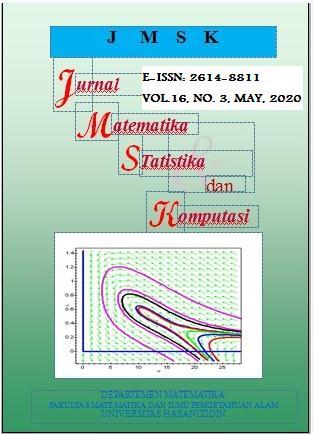Modeling of Quantile Regression to Know the Factors Affecting the High Spread Api Malaria in Indonesia
DOI:
https://doi.org/10.20956/jmsk.v16i3.8970Keywords:
Quantile Regression, Outliers, MalariaAbstract
The OLS method estimation is based on a normal distribution, so it is not appropriate to analyze a number of data that are not symmetrical or contain outliers. Therefore, quantile regression was developed which was not affected by outliers. This study compares quantile regression with OLS in the case of factors affecting malaria in Indonesia. The results show that the value of the Quantil Regression model is 0,832 and the MSE value is 0,182. In addition, the OLS model obtained a value of 0,681 and an MSE value of 0,231. So we get the conclusion that the best model is a quantile regression model. Further results were obtained that the main factors causing the spread of malaria in Indonesia were the factor of livable houses, poor population factors and physician factors.
References
Badan Pusat Statistika. (2014). Hasil Survei Sosial Ekonomi Nasional
Tahun 2014. Jakarta.
Budiantara, I.N. (2011), Penelitian Bidang Regresi Spline Menuju
Terwujudnya Penelitian Statistika yang Mandiri dan Berkarakter.
Seminar Nasional FMIPA Universitas Pendidikan Ganesha.
Chen, C. dan Wei. (2005). Computational Issues for Quantile
Regression. The Indian Journal of Statistics. Vol. 67, hal. 399-417.
Daoud, J. I. (2018). Multicollinearity and Regression Analysis. Journal
of Physics: Conference Series, 949(1). https://doi.org/10.1088
/1742-6596/949/1/012009
Ghozali, Imam. 2013. Aplikasi analisis Multivariat dengan program
SPSS. Edisi ketujuh. Semarang.
Gob, S. C. dan Knight, K. (2009). “Nonstandard Quantile-Regression
Inference”. Econometric Theory. Vol. 25, hal. 1415-1432 .
Gujarati, D. N. (2004). Basic Econometrics, 4th Edition. New York:
McGrahill. Co.
Hardle, W. (1990). Applied Nonparametric Regression. Cambridge
University Press. New York.
Hastie, T. J. dan Tibshirani, R. J. (1990). Generalized Additive Models.
Chapman and Hall. New York. London.
Kementrian Kesehatan Republik Indonesia. (2014). Profil kesehatan
Indonesia, Pusat data dan Informasi Kementrian Kesehatan. Jakarta.
Koenker, R. dan Machado, J. A. F. (1999). Goodness of fit and Related
Inference Process for Quantile Regression. Journal of the American
statistical Association. Vol. 94, no 448, hal 1296-1310.
Lin W, Zongwu, Li. (2015). Optimal smoothing in nonparametric
conditional quantile derivative function estimation. Journal of
Econometrics ScienceDirect vol. 188, hal. 502-513.
Mirontoneng, A.R, Ismanto, A.Y dan Malara, R. (2014). Analisis faktor-
faktor yang berhubungan kejadian malaria pada anak di wilayah kerja
PKM Tona kecamatan tahuna kabupaten Sangihe. Program Studi Ilmu
Keperawatan Fakultas kedokeran Universitas Sam Ratulangi Manado.
Schober, P., & Schwarte, L. A. (2018). Correlation coefficients:
Appropriate use and interpretation. Anesthesia and Analgesia, 126(5),
–1768. https://doi.org/0.1213/ANE.0000000000002864.
Susilowati, P, A. (2013). Analisis regresi pada prevalensi malaria
Provinsi Maluku Utara, Malauku, Papua Barat dan Papua dengan faktor
yang mempengaruhinya. Skripsi, Jurusan Statistika Institut Teknologi
Sepuluh Nopember.
Umeh, E. U., & Ojukwu, C. I. (2019). Effects of Influential Outliers in
Local Polynomial Techniques (Smoothing Techniques).8(1),19–22.
Downloads
Published
How to Cite
Issue
Section
License

This work is licensed under a Creative Commons Attribution 4.0 International License.
Jurnal Matematika, Statistika dan Komputasi is an Open Access journal, all articles are distributed under the terms of the Creative Commons Attribution License, allowing third parties to copy and redistribute the material in any medium or format, transform, and build upon the material, provided the original work is properly cited and states its license. This license allows authors and readers to use all articles, data sets, graphics and appendices in data mining applications, search engines, web sites, blogs and other platforms by providing appropriate reference.







